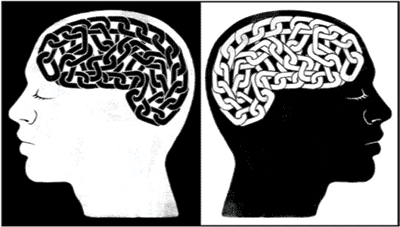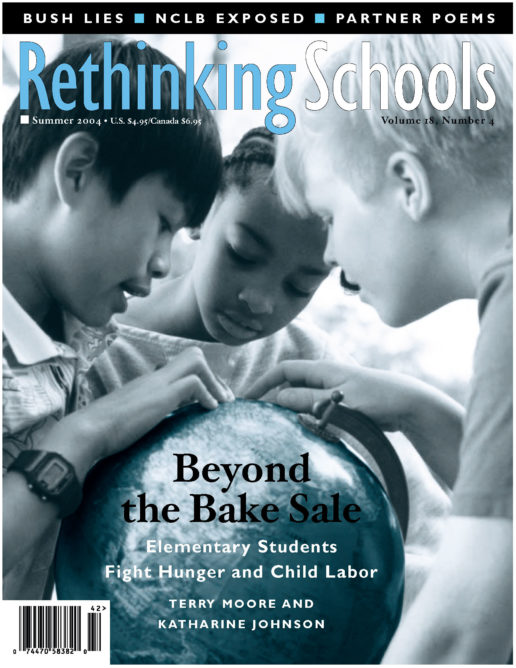Brown Doll, White Doll
Partner poems help students talk back to stereotypes
Illustrator: Edel Rodriguez
As women of color who both grew up in predominately white communities, we continuously worked to assimilate rather than celebrate who we were. It was difficult for a young African-American woman and a young half-Japanese, half-Caucasian woman to truly fit in to the places where we grew up. We longed to be what society portrayed as beautiful. Institutionalized images in magazines, on television, on school posters did not reflect who we were. We tucked it all inside, hoping it might disappear. But there are some aspects of our identity that cannot be hidden.

We met in the summer of 2002 at the Portland Writing Project, one of the sites of the National Writing Project, which provides teachers an opportunity to practice the art of teaching writing through use of their own writing, reflection, conversation, and collaboration with other teachers to create curriculum. In the class we read Warriors Don’t Cry, the remarkable autobiography of Melba Pattillo Beals, one of the Little Rock Nine, that brings students inside the lives of a family in the center of the Civil Rights Movement. Our assignment was to develop a writing lesson plan that used the book or the themes in the book.
We knew we wanted to create a lesson that would help our students celebrate who they were. We both taught in diverse classrooms: Heidi at the Monroe Teen Parent Program, an urban program in Portland Public Schools for middle-school and high-school teen mothers; and Shwayla at Harriet Tubman, an urban middle school. As we reflected on our own feelings, thoughts, and experiences growing up as people of color, we realized we had seen our students dealing with these same scarred self-images that hold them back. These scars manifest themselves through our continuous negative self-talk: “What guy is going to want to be with me with stretch marks all over my body?” “I got bad, nappy hair. I wish I had your good hair.” “Ooh, she’s too dark. I like light-skinned girls.”
When our students were brave enough to share their writing, we recognized their feelings of inferiority. They shared stories of isolation, eating disorders, drugs, poverty, abuse, being picked on, struggling with language, and wanting to be more like someone else. We want students to fight back against the images and stereotypes that devalue who they are.
Whether they are students of color struggling to find a sense of themselves, teen mothers wanting to fit back into their size three jeans, or students feeling disconnected from their culture and language, we want to validate who and what they are.
During the Writing Project, we wrote a partner poem (see “A Woman of Color,” at left), both to celebrate our own identities and to use as a model for our students.
One of our goals in this lesson was to help our students learn to speak about what makes them unique and resist changing who they are just to “fit in.” In our partner poem lesson, students created two-voice poems that celebrate what is often devalued in our society. We believe these poems are one way for students to fight back against the negative images that keep them disconnected from themselves. Writing partner poems also gives students opportunities to work collaboratively and to combine voices that are often unheard to create powerful pieces of writing.
Talking Back
Before we began the partner poem lesson in each of our classrooms, we reflected on the year with students, especially discussions of stereotypes and racism. In Shwayla’s class these discussions were prompted by studying Roll of Thunder Hear My Cry, the moving historical fiction set in Mississippi at the height of the Depression. It is the story of one family’s struggle to maintain their integrity, pride, and independence in the face of racism and social injustice . Heidi’s class reflected on the unit in which they read Warriors Don’t Cry. We both reviewed the media stereotypes that we had examined with our classes. One student in Heidi’s class said, “Women are always shown as needing to be rescued.” Another said, “People are always supposed to be skinny.” Another added, “And women are suppose to have nice figures, be pretty, have tiny feet, and be searching for the perfect man.” In Shwayla’s class, a Latino student said, “Latinos are seen as gang-affiliated criminals with scruffy facial hair and strong accents.” Another student added, “They also think all black people are uneducated.”
In both classes we reviewed the year and then introduced the partner poem, explaining that our critical analysis of these stereotypes led us to a place where we needed to talk back to them. Shwayla, for example, shared a time in middle school when she was stereotyped and hurt, and she lashed out at classmates for calling her “ebony and ivory.” Heidi talked to her students about a time in high school when she verbally attacked another student who made “Chinese eyes” at her and called her a “gook.” After sharing these personal examples, we handed out ” A Woman of Color,” the poem that we had written. We each explained that this was our attempt to fight back at the stereotypes. In each of our classes we chose a student to read the poem ahead of time to get the feel and the flow. That student was then able to read the poem with each of us for the rest of the class.
Because we wanted to teach them how to write a partner poem and not just appreciate ours, in each of the classes we asked the students to read the poem on their own and to highlight some of the categories they recognized in our poem — like hair, eyes, or culture. Some students struggled with this. In Heidi’s class many felt they should just highlight the entire poem because they found categories they identified with in each line. In retrospect, we should have encouraged them to look for one or two words that clarified the category and only highlight those.
Once students finished highlighting, we created a t-chart, with categories on the left side and colorful descriptions on the right, of all of the categories they found running through “A Woman of Color.” Categories included skin color, hair, language, culture, food, family, etc. We both asked students to add other categories that we had not listed. Then we also asked them to add their own descriptions to get a feel for the flow. For example, our students’ descriptions in the “skin color” category included the following:
Rich color of rice paper
Swirling taupe
Yellow and cream
Caramel colored latte
Hershey’s special dark chocolate
Vanilla mixed with strawberries
Peaches mixed with cherries
Smooth creamy vanilla ice cream
And here are some of their descriptions from the “language” category:
The native tongue whispered quietly, poetically
The rhythms of Ebonics call and answer
My gospel tongue thick with scripture
The teenage language that has to be quick to flip the scrip
The laid back and civilized language of natives
Once students finished their lists, Shwayla’s class had further discussion on “juicy language,” while Heidi’s students were ready to write. Students in both classes created t-charts like the one we made, with categories such as skin color, language, and generations or with physical attributes on one side and descriptive words and phrases for each category on the other side. We reminded students that they were talking back to stereotypes that boxed them in, so they should use powerful words.
Naturally, in both of our groups, there were students who couldn’t write fast enough and others who just stared at us defiantly. “This is stupid and I have nothing to write about!” “What is the point of this poem?” “I do not want to work with a partner!” We both found it helpful to sit down with individual students and remind them of some of their comments in our discussions throughout the year. In Heidi’s class, one student talked about her anger at being kept out of sports her whole life because she was a girl. Heidi encouraged her to use “being a woman” as a category. In both classes we noticed students who were reluctant to work with partners, so we sat with individuals and asked them to compare a few categories with the person next to them to see what they had in common. In retrospect, asking students to list for a few minutes and then share with the class might have taken some of the anxiety out of it for those who were struggling.

Once we sensed that students were slowing down in making their charts, we paired them up with another student — someone we believed they could work with and might feel comfortable sharing personal information with. Once they were in pairs, we both asked them to find a category they had in common and use the idea to write a line of the poem. This wasn’t always easy. An African-American student and a European-American student in Shwayla’s class who were working together had trouble identifying common categories.
One student explained, “We don’t even hang out with the same guys, what do we have in common?” Shwayla asked them to start by looking at each other. “We don’t have anything that looks alike,” one of them said. Shwayla explained that when we wrote “A Woman of Color” together, we were virtual strangers, of different races and nervous about sharing personal information. We found it helpful to start by sharing our lists, then asking each other questions about lines before we created sentences for our poem. The two boys used their eyes as their starting point. They began their poem with:
“My eyes are not a common color, but they are a beautiful color.”
“I may wear glasses, but four eyes are better then two.”
Heidi explained to students that they did not have to share all of the same categories. Two students volunteered their lines as an example that did not match.
“I don’t have to wear daisy dukes to be a woman.”
“I love my life and the way that I live it because I choose to live that way.”
The students seemed encouraged when they heard their classmates read aloud. We also reminded students that sometimes new lines arise from hearing a partner’s lines, so discussing each other’s words might spark ideas.
There are a number of ways that our students worked as partners. Some pairs compared categories, found what they had in common, and used those to create their lines together. Others read through their lists, called out lines, and had the other person answer back. And some students wrote out their own lines and then combined them with their partner’s lines.
To make the poems easier to read aloud, we asked the students to create scripts by writing down their lines in the correct order.
Once students finished their first drafts, we asked them to read to each other to check the flow, word choice, and rhythm. They seemed to find this the most enjoyable part. For many of our students, this is where it clicked. This is where their poems came to life. In each of our classes we heard shouts, laughter, and support as students encouraged one another with, “That’s a good one” or “That sounds good together.”
Finally, pairs of students volunteered to share their poems with the class. These poems were powerful enough that in Heidi’s class some students suggested they find other ways to share them. Students brought these poems to student art performances and displayed them on school bulletin boards. In hearing the exciting summaries from Heidi’s class, Shwayla decided to do a poetry slam, with microphone, spotlights, and a student DJ, incorporating other poetry lessons completed in her class.
Reflections
These activities allowed us to celebrate each other and ourselves. We laughed, joked, and learned about each other. Instead of focusing on what was different about one another, we celebrated our commonalities and have since become good friends. This is what we want to happen in our classrooms — a sense of community.
This partner poem lesson allows students an opportunity to find their own voices. It allows students to talk — and sometimes yell — back at stereotypes and unachievable images. Together, we as teachers found strength in our poem, and we hope that others will do the same.

